

Logical Fallacies: The Fallacy Files. Critical Thinker Academy - Home. Clearer Thinking. Ten Virtues for the Modern Age. The Virtues Project comes as a response to the wave of discussion and feedback that followed the publication of my book, Religion for Atheists, and a growing sense that being virtuous has become a strange and depressing notion, while wickedness and evil bask in a peculiar kind of glamour.
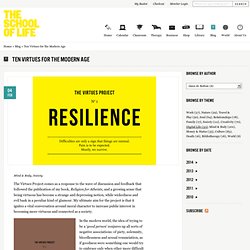
My ultimate aim for the project is that it ignites a vital conversation around moral character to increase public interest in becoming more virtuous and connected as a society. In the modern world, the idea of trying to be a ‘good person’ conjures up all sorts of negative associations: of piety, solemnity, bloodlessness and sexual renunciation, as if goodness were something one would try to embrace only when other more difficult but more fulfilling avenues had been exhausted. Throughout history, societies have been interested in fostering virtues, in training us to be more virtuous, but we're one of the first generations to have zero public interest in this.
FFR Foundation. Skeptic's Annotated Bible / Quran / Book of Mormon. Contradictions in the Bible poster. Contradictions in the Bible poster By . 2009.
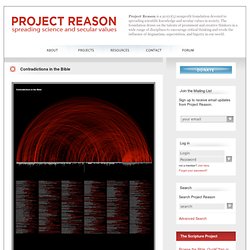
Photos. Visualization of the contradictions in the Bible taken from The Scripture Project by Steve Wells (see the Projects section of The bars that run along the bottom of the visualization represent the 1189 chapters in The Bible, with the length of each bar corresponding to the number of verses in each chapter. White bars represent the Old Testament and grey bars represent The New Testament. Graphic design: Andy Marlow Inspiration: Chris Harrison Print your own poster:22” x 33” or 33” x 44” RGB, 3mm bleed printing: recommended to print digitally on matte photographic paper.
Debating a Christian – The Atheist Handbook. Email by Jeremy L.
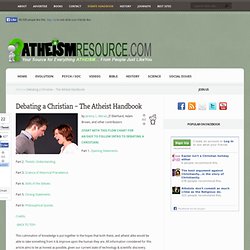
Moran, JT Eberhard, Adam Brown, and other contributors Part 1. Opening Statements. Part 2. RationalWiki. The Skeptic's Dictionary. The Quackometer - Debunking Handbook. Skeptoid. Skeptical Software Tools. Rbutr - Facilitating online discourse. Morality as Secular.
Mark S.

Halfon, (2004, Nassau Community College) That there is a difference between religion and morality is uncontroversial. How, then, can atheism be interpreted as a moral alternative? Although religion and morality reflect different values, they are deeply intertwined for most individuals. In many cases, a person’s moral principles are grounded in religious commitments. The principal problem with a divinely-based moral system is most obvious with respect to religious fundamentalism. When religious certitude is at the core of one’s world view, it is difficult to consider the possibility that one’s judgments are fallible.
Religious fundamentalism builds walls between people given the perception that God will reward only a select group. Atheists, instead, could base their moral ideals in humanism, that is, a philosophy that stresses the inherent value of all human beings. Additionally, atheists are more likely to act from pure motives. Some Moral Dilemmas. The Trolley Problem, not in Grassian.
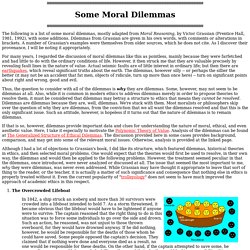
Suggested by Philippa Foot (1920-2010), daughter of Esther, the daughter of President Grover Cleveland, but of British birth because of her father, William Sidney Bence Bosanquet. A trolley is running out of control down a track. In its path are five people who have been tied to the track by a mad philosopher. Fortunately, you could flip a switch, which will lead the trolley down a different track to safety.
Unfortunately, there is a single person tied to that track. This is a classic "right vs. good" dilemma. The Costly Underwater Tunnel Compare: 112 men were killed during the construction of Hoover Dam on the Nevada-Arizona border (the "official" number was 98, but others had died from causes more difficult to identify -- or easier to ignore -- like by carbon monoxide poisoning): The first to die was a surveyor, J.G. Fallacies A fallacy is a kind of error in reasoning.

The list of fallacies contains 209 names of the most common fallacies, and it provides brief explanations and examples of each of them. Fallacies should not be persuasive, but they often are. Fallacies may be created unintentionally, or they may be created intentionally in order to deceive other people. The vast majority of the commonly identified fallacies involve arguments, although some involve explanations, or definitions, or other products of reasoning. Sometimes the term "fallacy" is used even more broadly to indicate any false belief or cause of a false belief. An informal fallacy is fallacious because of both its form and its content. Top 20 Logical Fallacies - The Skeptics' Guide to the Universe. Introduction to Argument Structure of a Logical Argument Whether we are consciously aware of it or not, our arguments all follow a certain basic structure.
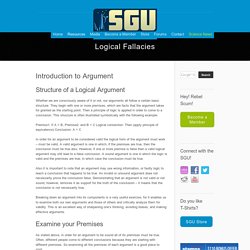
They begin with one or more premises, which are facts that the argument takes for granted as the starting point. Then a principle of logic is applied in order to come to a conclusion. This structure is often illustrated symbolically with the following example: Premise1: If A = B, Premise2: and B = C Logical connection: Then (apply principle of equivalence) Conclusion: A = C. A Philosophy Podcast and Philosophy Blog.